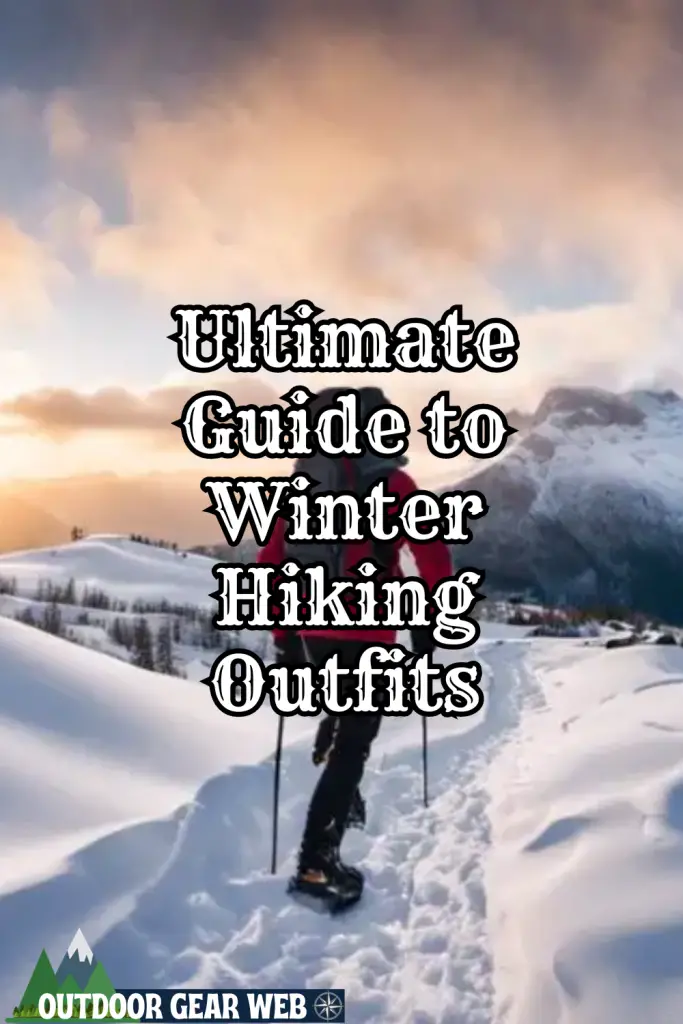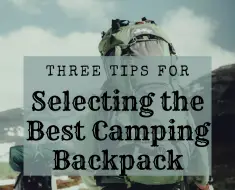
Embracing the great outdoors is a rewarding experience year-round, but it achieves a particular whimsical charm when undertaken amidst the snowy allure of the winter months. But as stunning as the snow-capped peaks and frosted paths can be, they bring along a unique set of challenges that demand thorough preparation – a task that starts with proper winter hike outfitting. Embarking on such excursions without the right gear could not only prove uncomfortable, but it can also expose you to serious health hazards such as frostbite and hypothermia. This piece endeavors to guide you through the complexities of putting together winter hiking outfits that marry comfort, functionality, and safety, all while considering the various influences the weather and the nature of the trail might have on your choice of apparel.
A Checklist for Your Winter Camping Trip?
The Need for Proper Winter Hiking Outfits
Sure, there’s a chill in the air. A soft carpet of snow has blanketed the mountains, turning the emerald green trails into a spectacle of pure white fantasy. Does that mean it’s time to hang up those hiking boots? Absolutely not! You’ll learn to love winter, once you’ve figured out how to embrace its icy clutches with an appropriate winter hiking outfit.
So, why is selecting the right winter hiking outfit essential? Well, allow the wildly wandering spirit inside you to embark on this snowy journey of discovery!
Winter Hiking Outfits and Safety
First off, it’s all about safety. Winter hiking is breathtakingly beautiful, but frostbite and hypothermia are definitely not on anyone’s adventure itinerary. Quality winter clothing acts as our personal force field against the harsh and cold world of winter out there. It regulates our body temperature, wicks away moisture, and keeps us dry and warm, letting us enjoy the snowy escapades rather than shivering our way back to the cabin.
Next, hiking in winter isn’t just about fighting the cold. It’s also a battle against the dampening forces of snow, sleet, rain, or your own sweat that can turn a cheerful venture into a damp squib. Proper winter hiking gear uses smart fabric technology to tackle condensation and moisture. It lets you move freely without feeling heavy, ensuring you efficiently explore the mesmerizing, snow-kissed landscapes unburdened.

Winter Hiking Outfits: Comfort, Flexibility, and Layering
What else? Oh yes, comfort and flexibility! Winter comes with its pack of challenges – drizzles, blizzards, or slippery slopes. However, the right outfit can make your trekking as smooth as hot cocoa on a frosty morning. Look for mobility-friendly designs that allow for effortless movement. Insulated jackets with pit zips, adjustable hoods, and internal gaiters can help adjust your body temperature during those challenging ascents and descents. Have a snug outfit that adapts to your adventure rhythm? Now that’s a winter win!
Consider, too, the layering system – a non-negotiable strategy for winter hiking trips. Wearing multiple thinner layers rather than one chunky garment allows for better heat regulation and easy ventilation. Typically, it involves three stages: a moisture-wicking base layer, an insulation middle layer, and a waterproof, breathable exterior shell. Voila, you’re covered!
Lastly, it’s not all survival talk – we’re explorers, not Spartans after all. The art of dressing warmly for a winter hike isn’t restricted to function alone. There’s room for a splash of adventure-inspired style too. Vibrant colors, stylish cuts, and textures can boost your mood and make you stand out even in a white-out.
Selecting the appropriate winter hiking outfit is your passport to enjoy winter’s many wonders. It keeps you safe, dry, comfortable, and yes, selfie-ready too. So, tie up those winter boots, layer up, and step out. The snowy mountains are calling – give them a stylish answer!
Components of a Winter Hiking Outfit
Harnessing the Beauty of Winter: Key Components to Your Essential Winter Hiking Outfit
There’s nothing quite like the purity of a winter landscape. The quiet serenity, punctuated only by the crunch of fresh snow beneath your boots, is one of the finest pleasures of a frost-kissed hike. But while the winter wonderland view may be breathtaking, neglecting proper clothing could make your adventure short-lived. Let’s explore the vital components you’ll need to stay warm, dry, and safe as you traverse the world’s chillier corners.
Headgear: The Frosty Forefront of Advantage
You lose 10% of your body heat through your head, making a good hat or beanie a non-negotiable necessity. Opt for materials like wool or fleece, which offer natural insulation. A neck gaiter is also a savvy addition to keep the icy drafts at bay. And don’t forget your sunglasses! Winter hikes often mean harsh, bright glares off the snow. Protect those peepers.

Hands: Embracing Warmth & Function
Gloves with a waterproof shell and thermal lining combine warmth and dexterity, a pairing as ideal as hot cocoa and marshmallows. For extreme cold, consider mittens with a separate finger liner – they provide extra insulation without sacrificing mobility.
Footwear: The Key to Every Great Journey
Winter hikes demand boots that are warm, waterproof, and fitted correctly. Misfit boots can cause blisters, a nightmare for any dedicated traveler. Look for boots lined with insulating material like Thinsulate or Primaloft, and make sure they’re high enough to prevent snow from sneaking in.
Socks: Remember, Wet Feet Equal Cold Feet
In addition to quality boots, your socks are critical. Avoid cotton since it retains moisture, chilling your toes. Instead, seek out socks made from merino wool, which wicks away sweat, keeping your feet dry and comfortable.
Trousers and Shirts: Protecting Your Core
While the emphasis on layering has been expressed, remember that your base layer, which is in contact with your skin, should be moisture-wicking. The mid-layer is all about that vital insulating factor. As for your outer layer, be sure it is waterproof and windproof. Ski trousers and a waterproof shell jacket typically make the perfect match.
Last but not least, no matter how fashion-forward your winter hiking outfit is, safety and comfort should always take the front seat. Adventure is a splendid thing, but it’s paramount to make sure that your winter hike is more than just bearable – it should be enjoyable, too. Remember, fellow nomad, that the world is full of beauty. Dress accordingly, and you’ll be prepared to explore it all, from every snowy peak to each frost-covered forest.
Selecting the Right Winter Hiking Outfit
Venturing into the bidirectional exchange between nature and adventure, winter hiking is an exhilarating experience often ignored when temperatures dip. Of course, the chilling winds and frosty trails can be intimidating; but with the correct attire, even the harshest terrains can turn into amicable playgrounds. Continuing from previous discussions, this part focuses on additional tips to master the art of dressing for winter hikes.
Winter Hiking Outfits: Sun and Face Protection
One frequently neglected aspect of winter hiking is sun protection. Despite the sun seeming tamer during winter, UV rays can bounce off snow, potentially damaging your skin or causing snow blindness. Sunglasses or glacier goggles are a must-have, providing essential eye protection. A broad-spectrum sunscreen, though seemingly counter-intuitive in frosty weather, protects exposed skin from UV damage.
Next up is face protection. A thermal balaclava can provide significant respite from freezing winds, safeguarding sensitive facial skin. It is immensely useful when wind speeds pick up, offering warmth without compromising exhalations.
Unexpected Weather
Traveling to lower-temperature regions or expecting snow? Consider an insulated parka. It serves as an additional outer shell and provides unmatched warmth with its typically duck-down or synthetic insulation. A parka with a detachable hood and materials providing wind and water resistance may be more costly but offers excellent durability and protection against various weather challenges.

Your legs also deserve love and care. Opting for lined hiking pants with built-in insulation keeps the lower body warm and protected. Look for pants with reinforced knees and bottoms for additional longevity. If super-low temperatures are expected, insulated snow pants designed for alpine conditions can be a lifesaver.
Your feet support all your adventurous quests and deserve paramount attention. Winter hiking boots need to have a roomy toe box to accommodate thicker socks and prevent toe numbness. Moreover, insulated boots with water-resistant capability will keep feet dry and warm in snowy conditions.
Look for gaiters made of a breathable yet waterproof fabric to protect your lower legs and footwear from snow. These handy accessories also keep dirt, pebbles, and bugs at bay on non-snowy hikes.
Styling Your Winter Hiking Outfits
Lastly, remember to have fun styling your winter hiking outfit. A pop of color can break the monotony of the winter white landscape. However, keep in mind that darker colors absorb heat better, and light colors reflect it. Therefore, if you are hiking in bright, snowy conditions, light-colored clothing may keep you cooler than dark ones.
Choosing the ideal winter hiking outfit is like decorating your adventure canvas. It enhances the fun, keeps safety in check, and elevates the overall hiking experience. An excursion into the winter wilderness thus becomes a medley of exhilaration, exploration, and self-discovery. So pack up, dress right, and venture out – life’s beckoning with the whispers of numerous undiscovered trails.
Care and Maintenance of Winter Hiking Outfits
Proper maintenance and care are just as vital as selecting the right winter hiking gear. With regular, mindful upkeep, your adventure equipment can weather all storms and elevate your winter escapades for years to come.
Gentle Washing
Despite the tough nature of winter hiking outfits, opt for a gentler cycle when washing. Vigorous washes can damage the fabric and impair water and wind resistance features. Also, resist the urge to add fabric softener; it can lessen the breathability of your gear.
Detergents
Ditch the traditional detergents for tech wash solutions instead. Normal detergents can clog up the ‘pores’ of your clothing and reduce its effectiveness against harsh weather conditions. Look for a detergent specifically designed for high-tech gear.
Air Drying over Heat
Tossing your winter gear into a dryer might seem convenient, but it’s not always beneficial for your gear’s longevity. High heat can cause damage to many high-tech, moisture-wicking materials. Embrace the benefits of air drying. It helps preserve the integrity of the fabric, waterproofing, and insulating features.
Post Washing Care
Re-applying a durable water-repellent (DWR) coating to gear after multiple washes helps preserve water resistance. Many outdoor stores sell DWR sprays that you can apply at home.

Storage
When not in use, store your winter hiking clothes in a cool, dry place. Moist, harsh environments can potentially damage the gear. Also, avoid folding the clothes. Instead, hang them up; it helps maintain the shape and minimizes the risk of wrinkling the fabric.
Gear-specific Care
Caring for your boots needs a different approach than your clothing. After each hike, try to clean off mud or dirt using a soft brush. Use a damp cloth for tougher stains. Dry them at room temperature to avoid cracking leather, warping the shape, and damaging the insulation.
Importantly, gear like sunglasses, goggles, and other accessories need special attention too. Always clean them with a soft cloth and store them in protective cases.
Routine Inspections
Conduct regular inspections for wear and tear on your outfit and gear. Be proactive in repairing any damage – a small tear or rip can rapidly escalate if not addressed promptly. Outdoor gear repair kits are available and straightforward to use.
Break-In Period
Before an adventure, take some time to ‘break in’ new gear. Wear new boots around the house, or on short walks, before they hit the trail. Not allowing your gear to mold into your shape can lead to an uncomfortable experience and unforeseen damage.
Remember, your winter outfit is an investment offering enjoyable, safe adventures. Treat it with the respect and care it deserves, and in return, it will heighten many more of your icy escapades. Stay adventurous and keep exploring the winter wilderness – happy hiking!
3 Tips for Finding Winter Gear on a Budget
Stay Cozy and Chic with These Three Stylish Winter Hiking Outfits
Winter camping isn’t just about staying warm; it’s an opportunity to showcase your unique style against a backdrop of snowy landscapes. Here are three fashion-forward yet functional winter camping outfits that will keep you snug and stylish during your cold-weather adventures.
1. Alpine Elegance
For a touch of mountain glamour, opt for a sleek insulated parka in a neutral tone – think soft greys or muted blues. Pair it with high-performance thermal leggings, ensuring both warmth and flexibility for those spontaneous snowball fights. Don’t forget a cozy faux fur-lined beanie and stylish snow boots to elevate your winter chic. This ensemble effortlessly blends sophistication with functionality, allowing you to embrace the alpine elegance of the great outdoors.

2. Cozy Cabin Couture
For a more relaxed and homey vibe, consider a chunky knit sweater paired with fleece-lined leggings. Opt for a quilted puffer vest to add a layer of warmth without sacrificing style. Top it off with a pom-pom beanie and trendy shearling-lined boots – perfect for those cozy cabin nights by the fire. This outfit seamlessly combines comfort with a touch of rustic charm, making you the epitome of cozy cabin couture.

3. Sleek Wilderness Explorer
If you’re aiming for a sleek and modern look, go for a streamlined insulated jacket paired with waterproof and windproof snow pants. Choose a bold color to make a statement against the winter backdrop. Accessorize with a versatile infinity scarf, touchscreen-compatible gloves, and a beanie with a playful faux fur pom-pom. Complete the look with insulated, yet fashion-forward, winter boots for a mix of style and functionality that’s perfect for the wilderness explorer in you.

Remember, winter camping is not just about surviving the cold; it’s an opportunity to express your unique style on a snow-covered canvas. Invest in pieces that not only keep you warm but also showcase your individuality. Whether you’re sipping hot cocoa by the fire or conquering snowy trails, these winter camping outfits will ensure you do it with flair. Embrace the beauty of winter in style!
Final Thoughts on Ultimate Guide to Winter Hiking Outfits
While the journey of discovering the perfect winter hiking outfit involves an intricate blend of individual preferences, budget considerations, and environmental factors, the emphasized focus remains on prioritizing protection and comfort above all else. Additionally, caring for and maintaining your chosen ensemble will ensure that your investment continues to safeguard you through many more winter escapades, as we have outlined. The beauty of winter hiking should be enjoyed without the threat of bodily harm, and to do so, a well-thought-out, functional outfit that caters to the hiker’s needs and the demand of the trails is paramount. May the trails be with you, winter hiker.











